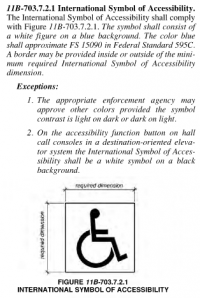-
Welcome to The Building Code Forum
Your premier resource for building code knowledge.
This forum remains free to the public thanks to the generous support of our Sawhorse Members and Corporate Sponsors. Their contributions help keep this community thriving and accessible.
Want enhanced access to expert discussions and exclusive features? Learn more about the benefits here.
Ready to upgrade? Log in and upgrade now.
You are using an out of date browser. It may not display this or other websites correctly.
You should upgrade or use an alternative browser.
You should upgrade or use an alternative browser.
Ca code section please
- Thread starter ICE
- Start date
Mr209Smith
REGISTERED
I am not even sure what a 2?x30 clear space is supposed to provide at the (assumed?) dining surface, marked or not.
Mr209Smith
REGISTERED
Realized after that they may just want a squarish ISA on the floor to designate the seating as accessible, but I've never seen anyone require it.I am not even sure what a 2?x30 clear space is supposed to provide at the (assumed?) dining surface, marked or not.
mark handler
SAWHORSE
2019 CBC 11B-221 Assembly Areas
11B-221.1 General
Assembly areas shall provide wheelchair spaces, companion seats, designated aisle seats and semi-ambulant seats complying with Sections 11B-221 and 11B-802. In addition, lawn seating shall comply with Section 11B-221.5.
11B-221.2 Wheelchair Spaces
Wheelchair spaces complying with Section 11B-221.2 shall be provided in assembly areas with fixed seating.
Note: When required wheelchair spaces are not occupied by persons eligible for those spaces, individual, removable seats may be placed in those spaces.
11B-221.2.1 Number and Location
Wheelchair spaces shall be provided complying with Section 11B-221.2.1.
11B-221.1 General
Assembly areas shall provide wheelchair spaces, companion seats, designated aisle seats and semi-ambulant seats complying with Sections 11B-221 and 11B-802. In addition, lawn seating shall comply with Section 11B-221.5.
11B-221.2 Wheelchair Spaces
Wheelchair spaces complying with Section 11B-221.2 shall be provided in assembly areas with fixed seating.
Note: When required wheelchair spaces are not occupied by persons eligible for those spaces, individual, removable seats may be placed in those spaces.
11B-221.2.1 Number and Location
Wheelchair spaces shall be provided complying with Section 11B-221.2.1.
Yikes
SAWHORSE
Mark, I think his question is: where is the 4"x4" ISA symbol "permanent placard" required by code?2019 CBC 11B-221 Assembly Areas
11B-221.1 General
Assembly areas shall provide wheelchair spaces, companion seats, designated aisle seats and semi-ambulant seats complying with Sections 11B-221 and 11B-802. In addition, lawn seating shall comply with Section 11B-221.5.
11B-221.2 Wheelchair Spaces
Wheelchair spaces complying with Section 11B-221.2 shall be provided in assembly areas with fixed seating.
Note: When required wheelchair spaces are not occupied by persons eligible for those spaces, individual, removable seats may be placed in those spaces.
11B-221.2.1 Number and Location
Wheelchair spaces shall be provided complying with Section 11B-221.2.1.
In the sections you quoted above, the only place I see "identification" signage is in 802.4.2 for "designated aisle seats"
Maybe it’s common sense … to keep the restaurant staff from placing a chair there, and to make it obvious that the restaurant has a dedicated HC space.where is the 4"x4" ISA symbol "permanent placard" required by code?
mark handler
SAWHORSE
How do you "designate" (per Code) something without identifying it to the end users and "regulators". You can callout all kinds of stuff on the plans, how is the guy/girl making $8 bucks an hour going to know that?Mark, I think his question is: where is the 4"x4" ISA symbol "permanent placard" required by code?
In the sections you quoted above, the only place I see "identification" signage is in 802.4.2 for "designated aisle seats"
California minimum wage is $14.00 per hour.
Yikes
SAWHORSE
The original post was not about the operators of the facility. It was about a building inspector writing a "correction" for which there is no code citation to indicate a violation.How do you "designate" (per Code) something without identifying it to the end users and "regulators". You can callout all kinds of stuff on the plans, how is the guy/girl making $8 bucks an hour going to know that?
How does a building inspector say this is a "correction", when there is no code violation?
mark handler
SAWHORSE
Show How you "designate" the space.
Code does not say to whom, therefore, designate to all.
Show How you "designate" the space to others.
Code does not say to whom, therefore, designate to all.
Show How you "designate" the space to others.
That happens a lot more than people know. I have hundreds of examples.How does a building inspector say this is a "correction", when there is no code violation?
Last edited:
Bluffing. Either from ignorance or arrogance.How does a building inspector say this is a "correction", when there is no code violation?
Yikes
SAWHORSE
In my opinion, you "designate" it on the plans, analogous to how you show 60" turning circle on the plans to demonstrate to the plan checker that you have provided enough designated space for wheelchair maneuvering.Show How you "designate" the space.
Code does not say to whom, therefore, designate to all.
Show How you "designate" the space to others.
Yikes
SAWHORSE
Mr. Inspector
SAWHORSE
I don't know of a IBC or ANSI 117.1 section that requires ISA on an accessible seating space at a table. The biggest problem I have with accessible tables is they use tables that have a center column all the time which does not allow for the toe space because of the large round base or X base. Just wondering if others fail accessibility inspections because of this because I do every time when an accessible seating space is required.
In San Diego that is reviewed during plan check and sometimes at final.I don't know of a IBC or ANSI 117.1 section that requires ISA on an accessible seating space at a table. The biggest problem I have with accessible tables is they use tables that have a center column all the time which does not allow for the toe space because of the large round base or X base. Just wondering if others fail accessibility inspections because of this because I do every time when an accessible seating space is required.
Mr209Smith
REGISTERED
We would do the same. At plan check, if the tables show a center column (we all know they don't always show that), I make them detail the accessible one with at least a plan view showing how it will meet the minimum clear requirements.I don't know of a IBC or ANSI 117.1 section that requires ISA on an accessible seating space at a table. The biggest problem I have with accessible tables is they use tables that have a center column all the time which does not allow for the toe space because of the large round base or X base. Just wondering if others fail accessibility inspections because of this because I do every time when an accessible seating space is required.
As suggested by many, identification of accessible seating areas is not required unless it is a designated aisle seat.
For the typical restaurant dining area, it is not required that signage or other marking be provided to indicate accessible use. If signage were required, it would be found in IBC Section 1111.1 (below).
1111.1 Signs
Required accessible elements shall be identified by the International Symbol of Accessibility at the following locations.
For the typical restaurant dining area, it is not required that signage or other marking be provided to indicate accessible use. If signage were required, it would be found in IBC Section 1111.1 (below).
1111.1 Signs
Required accessible elements shall be identified by the International Symbol of Accessibility at the following locations.
- Accessible parking spaces required by Section 1106.1.
Exception: Where the total number of parking spaces provided is four or less, identification of accessible parking spaces is not required. - Accessible parking spaces required by Section 1106.2.
Exception: In Group I-1, R-2, R-3 and R-4 facilities, where parking spaces are assigned to specific dwelling units or sleeping units, identification of accessible parking spaces is not required. - Accessible passenger loading zones.
- Accessible rooms where multiple single-user toilet or bathing rooms are clustered at a single location.
- Accessible entrances where not all entrances are accessible.
- Accessible check-out aisles where not all aisles are accessible. The sign, where provided, shall be above the check-out aisle in the same location as the checkout aisle number or type of check-out identification.
- Family or assisted-use toilet and bathing rooms.
- Accessible dressing, fitting and locker rooms where not all such rooms are accessible.
- Accessible areas of refuge in accordance with Section 1009.9.
- Exterior areas for assisted rescue in accordance with Section 1009.9.
- In recreational facilities, lockers that are required to be accessible in accordance with Section 1109.9.
Mr. Inspector
SAWHORSE
I almost never see furniture on plans. And if they did they don’t show what kind of legs they have.
I have made a couple restaurants replace the minimum number of center column tables with four leg tables to comply but if I stop by after the CO The center column tables are back.
I have made a couple restaurants replace the minimum number of center column tables with four leg tables to comply but if I stop by after the CO The center column tables are back.
ADAguy
REGISTERED
Good one Mark, code clarification required?Show How you "designate" the space.
Code does not say to whom, therefore, designate to all.
Show How you "designate" the space to others.




